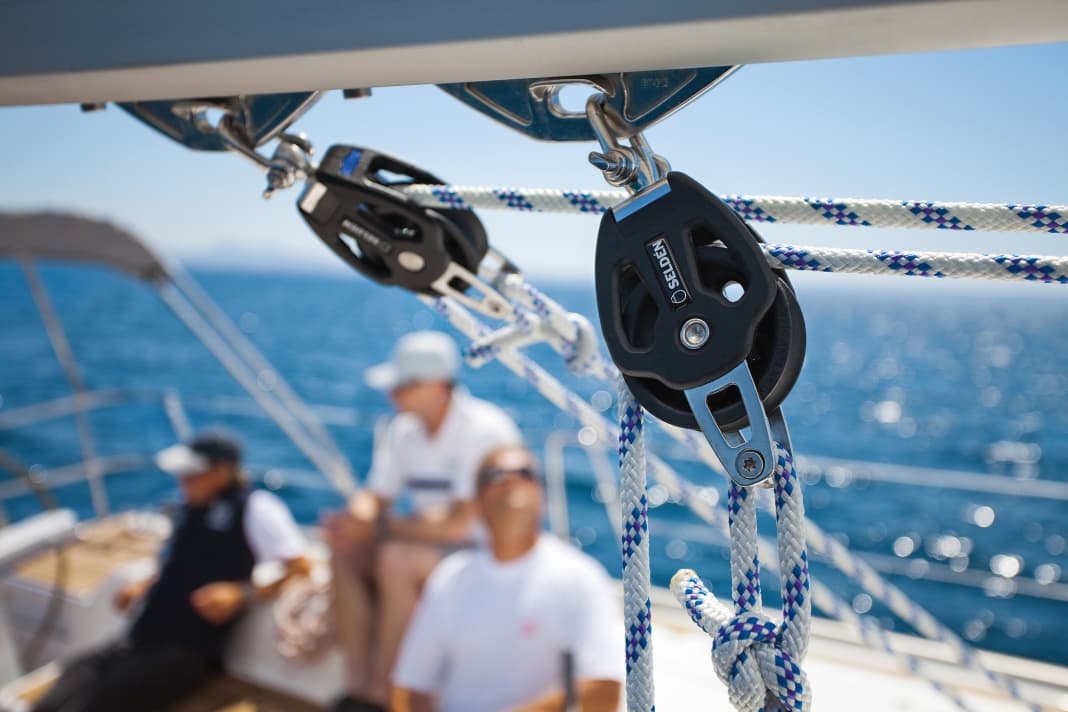





If you want to buy a new sheet, halyard or mooring line, you are faced with two important questions when making your choice: Is the material suitable for the application and is the line strong enough?
The question of material is easy to answer based on requirements such as elongation behaviour and abrasion resistance; the correct dimensioning of the rope is more complicated. The manufacturer specifies the breaking load of the rope. What is actually relevant, however, is the working load, i.e. the force that should not be exceeded in everyday use. This is only a quarter of the breaking load. A high level of safety is therefore usually factored in for ropes in order to be able to withstand load peaks, for example, or to hold even if it is slightly damaged. If you stick to the working load when dimensioning, you should be on the safe side.
So much for a simple calculation, but every line has to be connected to shackles, clews or poles somehow. This means that it is knotted or spliced.
It is well known that knots reduce the strength of the line - but how much does the breaking load and therefore the working load decrease? Both variables are always based on the weakest point in the system. This means that if a knot reduces the breaking load of a line by around 80 per cent, i.e. only 20 per cent of the original value, the working load is also only a quarter of this 20 per cent, i.e. only 5 per cent instead of 25 per cent without a knot.
But are there knots that are particularly problematic and particularly suitable? To clarify these questions, we tested the most common knots for joining two lines on a tensile testing machine. In each case with ten millimetre thick rope. In order to be able to make practical statements, we used the Plastimo XM 32 line (breaking load 2096 decanewtons), an inexpensive polyester product, and the Gleistein Megatwin Fall (breaking load 4132 decanewtons), a Dyneema rope. There are major differences due to the design.
Knots in polyester more resilient than in Dyneema
In knots, it is mainly the sheath that pinches. This is not a major problem with polyester ropes, as the sheath and core bear the loads almost equally. The situation is different with Dyneema ropes. They derive their enormous strength almost exclusively from the very smooth core. If this slips in the knot, too much load is transferred to the sheath - and it breaks. Without an intact sheath, the core slips completely out of the knot with almost no effort, and the connection is broken. The term "knot breaking load" is somewhat misleading in this case. Whereas in polyester ropes the line usually breaks in the knot at the point of greatest deflection, in dyneema ropes the knot slips apart and the line itself only breaks in the cover. In the following, we refer to both as breaking, as the connection is interrupted.
Good to know: With the exception of the eye connection formed with the double figure-of-eight knot, all knots tied into the Dyneema halyard failed due to this core-sheath slippage, even at alarmingly low loads. Based on these findings, it is reasonable to assume that rope constructions with an additional intermediate cover are likely to be more durable, as the force is better transferred to the core.
Rope shackle with good values
This automatically raises the question of how well the soapy fibre holds during splicing. After all, the braided hose is only inserted into each other. We also examined this on the test bench and tested the two ways of attaching a shackle.
The load capacity of Dyneema rope shackles is just as interesting. If you opt for prefabricated goods, there is also a manufacturer's specification here. However, this varies from producer to producer between 50 and 80 per cent of the values of the original rope of the same thickness. Reason enough to examine our self-spliced shackles. There is good news here: They don't need to hide behind the professional products and can even cope with considerably more than the simple cordage.
However, there are also small differences depending on the design: the version with exposed parten seems to be a little stronger, as the forces are better distributed over individual strands. The shackle knotted according to a reader's idea performs surprisingly well. It can be made without splicing.
What cordage shackles are suitable for and how they are easy to make yourself, we explain in this article.
Loss of breaking load of individual nodes
Cross knot: - 88 %

The cross knot is by far the worst solution for connecting two lines. The holding forces are low regardless of the material. Just 12 per cent of the breaking load of the Dyneema rope can be used, compared to 23 per cent for polyester.
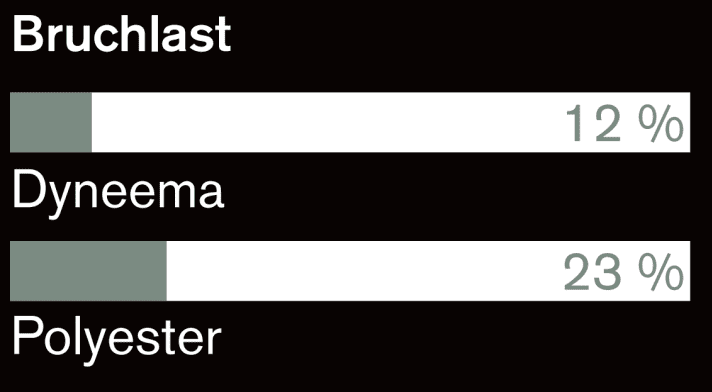
Schotstek: - 88 %

The sheet knot is the classic knot for joining two lines of the same or different strengths - but it weakens the connection considerably. With polyester, the rope breaks and the Dyneema rope simply slips through. A lot of loss here too.
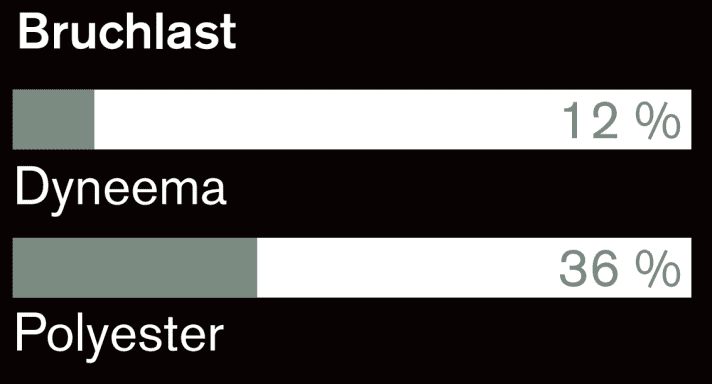
Double sheet stay: - 80 %

The double sheet stay has two loops, does this also provide more safety? What significantly improves the durability of polyester hardly helps with Dyneema ropes. The knot slips at a tensile force of 800 decanewtons or 20 per cent of the breaking load.
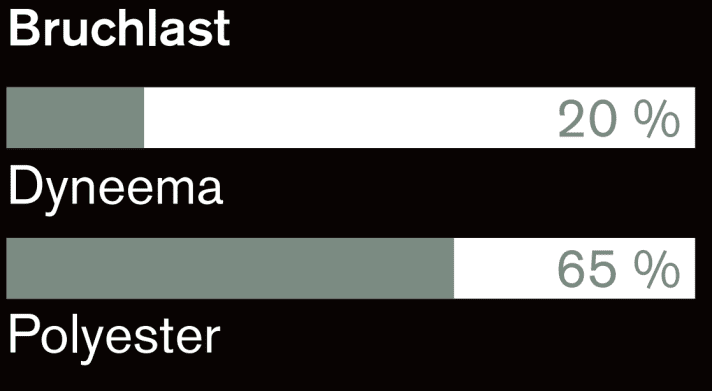
Fishing pier: - 70 %

The fisherman's knot is a simple connection of two overhand knots and is a viable solution for polyester ropes. With the Dyneema rope, however, the smooth, load-bearing core slips in the sheath, which is why it fails at 30 per cent of the breaking load.
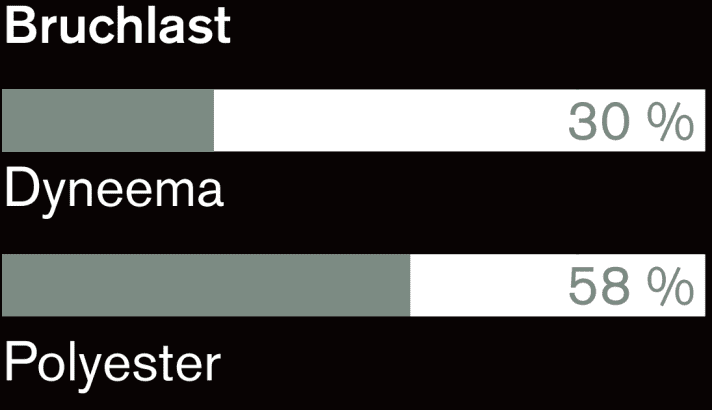
Bowline: - 53 %

Whether as an eye for mooring or for connecting two ropes: the bowline is popular and tried and tested. In fact, it can even hold more than 50 per cent of the breaking load of dyneema ropes before the cover fails and the core slips through.

Double eight: - 47 %

The double figure of eight is often used by firefighters and climbers for belaying. The eye knot weakens the connection comparatively little - and is therefore a good alternative to the bowline. To maximise the breaking load, the parallel sections must not cross.
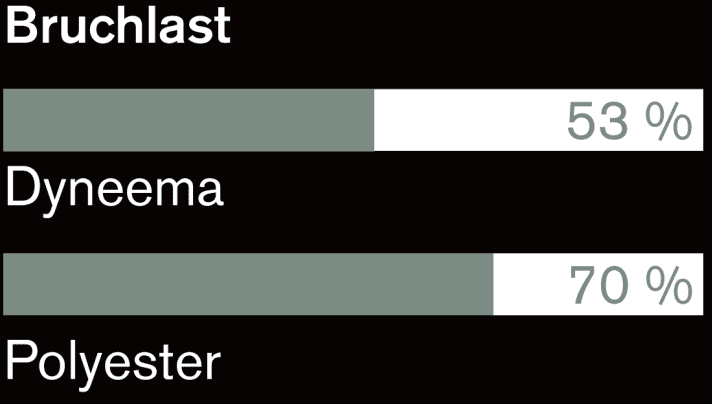
Loss of breaking load due to splicing
Where the splice gives up

In order for the dyneema fibres to develop sufficient friction, the splice must be between 48 and 60 times the length of the rope diameter. It rarely breaks at the eye, but usually at the end of the thickening, so the inner end should be tapered.
Eye or overcast: - 10 %
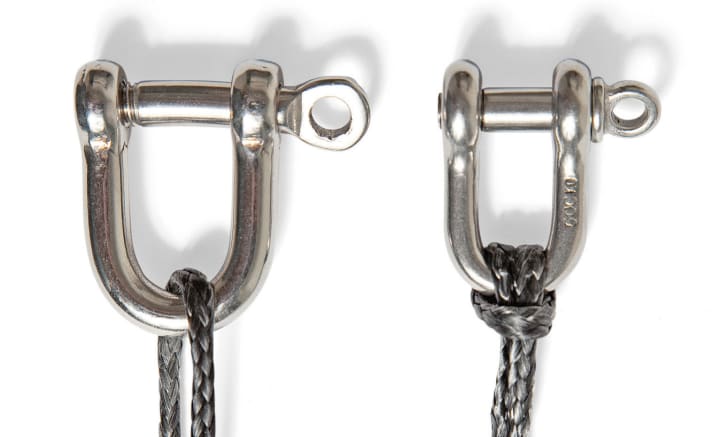
If the line is to be fitted with a shackle, there are two options: Either a simple eye is formed, or the shackle is attached by means of a loop. In tensile tests, both variants proved to be equally strong. If the splice is long enough, only 10 per cent of the breaking load is lost.
What cordage shackles can withstand
Simple shackle: + 40 %



The classic cordage shackle with interlocking parts has a breaking load of around 140 per cent of the dyneema rope used. The outer running part usually gives up at the beginning of the stopper knot. This is where the inner part emerges again, causing the braid to be loaded unevenly.
Shackle with two parts: + 50 %



The parallel strands of this shackle design absorb the force more evenly, which is why the breaking load is slightly higher at 150 per cent of the material value. This rope shackle also usually breaks at the lower end of the stopper knot.
Knotted shackle: + 40 %



This shackle can be produced without any splicing tools. Instead of splicing, the eye is simply formed by a half turn. This hardly reduces the breaking load. It fails below the stopper knot.

